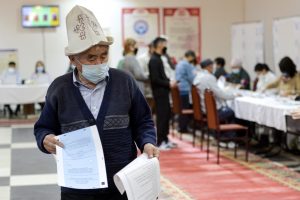[ad_1]
Magazine
Local elections provide a window into the state of Kyrgyz politics – and what might come next in the three decade-long game of political musical chairs.

A man in a Kyrgyz national hat casts his ballot at a polling station during the referendum in Bishkek, Kyrgyzstan, Sunday, April 11, 2021.
Credit: AP Photo/Vladimir Voronin
On April 11, voters in Kyrgyzstan went to the polls for the third time in six months. This time they cast votes in local elections and on a constitutional referendum, which legal experts and civil society groups have sharply criticized for slashing checks and balances on presidential power.
Only about one in three eligible voters participated in the polls. The referendum passed with about 80 percent of votes in favor, though less than 40 percent of Kyrgyzstan’s 3.6 million voters took part. The abysmally low turnout – still legally binding, per a 30 percent turnout minimum passed in a 2016 referendum – could be the result of election fatigue, disillusionment with politics in a country where the promises of consecutive revolutions have gone unfulfilled, or the inconvenience for internal migrants to return home to vote. Although Kyrgyzstanis seem to be opting out of formal mechanisms for political participation, the three decade-long game of political musical chairs continues.
The country’s party landscape has been in shambles since discontent with the results of parliamentary elections held last October spiraled into a revolution that resembled kicking down a rotting door more than a coherent national uprising. April’s local elections served as a test of viability on the national stage and the results offer some insight as to what the next few months have in store.
Local Elections and Party Consolidation
In Kyrgyzstan, where parties function more as vessels for the careers of individual politicians than coherent ideological platforms, the success of parties tends to be driven by wide recognition of the personalities at the top of the candidate list.
Local elections are one mechanism for party consolidation and serve as a signal of party strength both to voters and other political elites. This year, over 8,300 local legislative positions were up for election in 28 cities and 420 villages across Kyrgyzstan. 2016 was the last time local elections were this massive, and this year there were even more races because a handful of municipalities were upgraded to official “city” status and because a slate of races were delayed from last April due to COVID-19.
[ad_2]
Source link